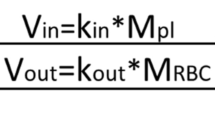Abstract
Fast transport kinetics of 51Cr (VI) into red blood cells (RBCs) in vitro were studied. No significant species differences were found between RBCs of man and rat. The uptake of 51Cr (VI) by RBCs in whole blood was composed of two different first order processes of different velocities (apparent t1/2 of 22.7 s and 10.4 min for man and 6.9 s and 10.1 min for rat, respectively). However, even after longer time periods a fixed portion of approximately 15% of the administered dose remained in the plasma and did not penetrate into RBCs Over the entire concentration range studied (10 μM–50 mM), the fast initial uptake followed Michaelis-Menten kinetics. The maximal capacity of this Cr(VI) transport into RBCs of man and rat was 3.1×108 CrO4 2− ions × cell−1 × min−1 and 2.5×108 CrO4 −2 ions × cell−1 × min−1, respectively. It is likely that Cr(VI) is transported into RBCs via a physiological anion carrier (“band-3-protein”).
Similar content being viewed by others
References
Bianchi V, Celotti L, Lanfranchi F, Majone F, Marin G, Montaldi A, Sponza G, Tamino G, Venier P, Zentedeschi A, Levis AG (1983) Genetic effects of chromium compounds. Mutat Res 117: 279–300
Dalmark M (1975) Chloride transport in human red cells. J Physiol 250: 39–64
Deuticke B (1967) Über die Kinetik der Phosphat-Permeation in den Menschen-Erythrozyten bei Variation von extrazellulärer Phosphat-Konzentration, Anionen-Milieu und Zell-Volumen. Pflügers Arch 296: 21–38
Gray SJ, Sterling K (1950) The tagging of red cells and plasma proteins, with radioactive chromium. J Clin Invest 29: 1604–1613
Hayes RB (1982) Carcinogenic effects of chromium In: Langard S (ed) Biological and environmental aspects of chromium. Elsevier Biomedical Press, Amsterdam, pp 221–247
Hladky SB, Rink TL (1977) pH-Equilibrium across the red cell membrane. In: Ellory JC, Lew VL (eds) Membrane transport in red cells. Academic Press, London, pp 115–135
ICHS (1973) Standard techniques for the measurement of red-cell and plasma volume. Brit J Haem 25: 801–814
Korallus U, Harzdorf C, Lewalter J (1984) Experimental basis for ascorbic acid therapy of poisoning by hexavalent chromium compounds. Int Arch Occup Environ Health 53: 247–256
Langard S, Vigander T (1983) Occurence of lung cancer in workers producing chromium pigments. J Ind Med 40: 71–74
Ormos G, Manyai S (1977) Chemical modification of erythrocytes. Effect on the velocity of chromate uptake. Acta Biochim Biophys Acad Sci Hung 12: 343–352
Prins HK (1962) The binding of 51chromium by human erythrocytes. Vox Sang 7: 370–372
Rollinson CL, Rosenbloom E, Lindsay J (1967) Reactions of chromium (III) with biological substances. In: Proceedings of the 7th International Congress of Nutrition, Hamburg 1966, Vol 5, Pergamon Press, Oxford, pp 692–697
Rothstein A, Cabantchik ZI, Knauf P (1976) Mechanism of anion transport in red blood cells: Role of membrane proteins. Fed Proc 35: 3–10
Samitz MH, Scheiner DM, Katz S (1968) Ascorbic acid in the prevention of chrome dermatitis. Arch Environ Health 17: 44–45
Schnell KF, Gerhardt S, Schöppe-Fredenburg A (1977) Kinetic characteristics of the sulfate self-exchange in human red blood, cells and red blood cell ghosts. Membr Biol 30: 319–350
Sunderman F (1984) Recent advances in metal carcinogenesis. Ann Clin Lab Sci 14: 93–122
Tkeshelashvili LK, Shearman CW, Zakour RA, Koplitz RM, Loeb LA (1980) Effects of arsenic, selenium and chromium on the fidelity of DNA synthesis. Cancer Res 40: 2455–2460
Tsapakos MJ, Wtterhahn KE (1983) The interaction of chromium on nucleic acids. Chem Biol Interact 46: 265–277
Wiegand HJ, Ottenwälder H, Bolt HM (1984) Toxicol Lett 22: 273–276
Author information
Authors and Affiliations
Rights and permissions
About this article
Cite this article
Wiegand, H.J., Ottenwälder, H. & Bolt, H.M. Fast uptake kinetics in vitro of 51Cr (VI) by red blood cells of man and rat. Arch Toxicol 57, 31–34 (1985). https://doi.org/10.1007/BF00286571
Received:
Accepted:
Issue Date:
DOI: https://doi.org/10.1007/BF00286571




